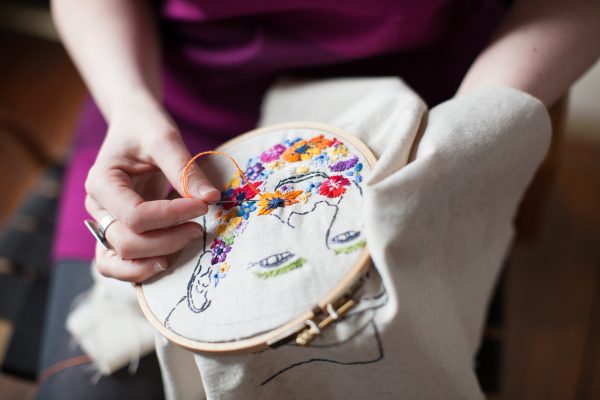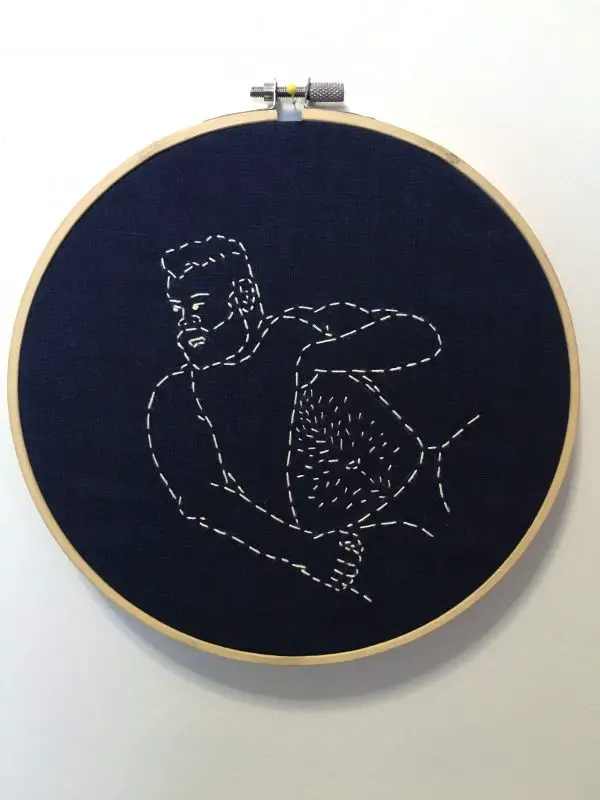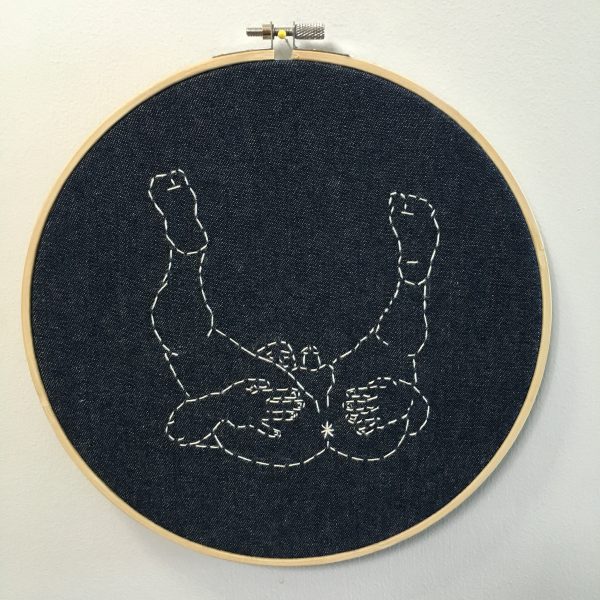
Welcome to Inspired To Stitch, where Olisa Corcoran connects with other textile creators to discover their inspiration.

My fandom of Rebecca Levi started in LA.
I first met the Brooklyn-based artist on Sunset Blvd. Curator Ellen Schinderman had organized an artists’ brunch for those of us showing work in Stitch Fetish 4. Over waffles and coffee we all discussed our artwork and techniques.

At the opening that night, I instantly fell in love with her spare, sashiko-style embroideries of large-bodied men posing for selfies. In white running stitch on a dark denim background, Levi captured an intimate, self-celebration of these bodies in a way I’ve never seen before. I was incredibly moved. (These Sashiko Bears were part of her series #100tumblrbearscantbewrong, based on photos of Bears on Tumblr.)
Levi’s work plays with desire, gender, sexuality and domesticity. With a lighthearted, often whimsical touch, she creates embroidered subversions of heteronormativity that excite and challenge her viewers. And she has a lot to say.

This winter, Levi spoke at the Maryland Institute College of Art’s “Queer Threads” symposium . She shared details of her source materials and inspiration, specifically queer narratives in mid-Century pinups and physique magazines and how this coded imagery became source material for her drawing practice and later her embroidered artwork.
What follows is a conversation about Levi’s art and practice conducted over email.

I admire your work with the male nude in the Sashiko Bear series. You seem to mix the tradition of Classic male nude, with the Neo-Platonic ties between beauty and heroism, with the playfulness of the selfie. The use of the sashiko stitching against the dark background give the pieces a monumental quality. Thinking about both process and concept, what is it about the Bear bodies that draws you to represent them this way in your work?
When I first started embroidering bears about 5 years ago, I did so as a response to the classical idealized slender, hairless bodies pervasive in mid-century physique magazines and in contemporary clone culture. I wanted to celebrate this larger body-type and physical expression that I thought was underrepresented. I referenced similar tropes and costuming that one might see in these magazines – including playful masculine archetypes in pieces like Gladiator Bear, Spartan Bear, Eagle Scout Bear.

But even just 5 years later bears have become much more visible and accepted, even pervasive – both in and out of gay culture. It’s become almost jarring to meet a man of a certain age without a beard. Certainly the internet has accelerated the distribution of this trend, and globally. And bear culture has evolved its own rules, constraints, and implied conformity.

I originally planned the Sashiko Bear series to play with poses typically seen in representations of the female nude in art – particularly the “odelisk.” There’s a tradition of male artists exploring female curvaceousness and the “Rubenesque,” but comparatively little of the reverse, and I wanted to respond to this. I tried to find as many odelisk-like and classic poses of bears on tumblr as I could, so the early works in this series more explicitly reference this. But I got bored, and expanded to standing, sitting, kneeling, and “happy baby” poses.

And yes, I love a selfie pose. The element of self determination – not just taking the photo in an intimate moment, but choosing to share and distribute it, seems enormously empowering. And then it reverberates within a huge ecosystem. I’m just one element participating in that call and response.
I also really enjoy putting cell phones in these pieces, as they’re a curious anachronism to see with the traditional sashiko stitching.

In terms of process, how do you organize your projects/ideas? Do you keep a sketchbook, journal or clip file? How many pieces do you typically have in process at one time?
I keep a small moleskin grid paper notebook with me to jot down ideas, and ideally, transfer the better ones to Evernote to keep a record in a central location. The grid paper is also nice for sketching patchwork concepts. I keep folders on my computer of source material, organized by series.

I typically have 2-3 projects actively in process at one time. I need to switch it up to keep engaged. The larger pieces can be a bit of a marathon of at least 80 hours of work or more, which can be frustrating. So I like to take a break with the sashiko bears, which I can finish quicker, to reward myself with the satisfaction of completion. After a few of these, I get hungry for color, and need to switch it up with a flower beard. Right now I have at least 10 pieces in progress. I’ll reach an impasse sometimes, and need some time and distance before I can envision how to complete a piece.
I also try to experiment with new techniques and materials to keep things fresh in between the “marathon” pieces.

Can you tell us about how your work with series (the Flowered Beards, Bears, Sashiko Bears) allows you to explore your ideas and imagery?
I find the idea of a “series” itself very motivating – it has a certain gravitas. So I tend to call things a series right away – even before I’ve finished the first one. It invites an energy and curiosity about how things will unfold over time, and helps me commit to explore a particular theme. I mean if I’ve told people I’m working on a series, I have to do it, right?

What role, if any, does the online community of artists play in your life as a working artist?
When I first started doing this, the embroidery community on Flickr and Blogger were a huge help and influence on my work. I had never actually sewn anything before, and I didn’t have any friends or relatives to turn to for guidance and mentoring – all my learning had to come from the internet and books.

And while some of my peers did grow up crafting, a lot of our fellow embroidery artists are largely self taught, so there’s a camaraderie in sharing tips and frustrations.

I now post on Instagram, and it’s been fun to see other artists’ work evolved and to develop new connections here – and happily, some of these relationships have evolved into participating in group shows, and real-world friendships. What could be better than that? I’m an outgoing person, so it’s a huge relief to have a sense of community around such a solitary art practice. Really, this is tremendously gratifying.

Finally, what artwork are you currently working with that has you most excited?
I’m most excited about the flower beards. Flowers are a traditional embroidery motif that invite endless experimentation. And bears and beards are my current muse. So it’s a wonderful way to spend time – a lot of time – with things I love and appreciate.

*******************************************************************************************************************************************************
In addition to being a talented, thoughtful artist, Levi is incredibly warm and generous. She took me on a tour of her Brooklyn studio this Spring and shared so much about her practice and techniques. It was a huge treat to see! She is true advocate for other artists and for the Queer community.
I encourage everyone to follow Levi on Instagram for a vibrant, ongoing view of her work, her life and her muses.






